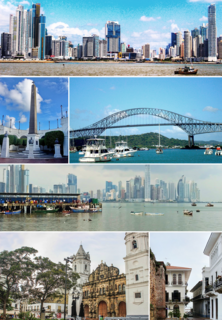
Panama City, also simply known as Panama, is the capital and largest city of Panama. It has an urban population of 880,691, with over 1.5 million in its metropolitan area. The city is located at the Pacific entrance of the Panama Canal, in the province of Panama. The city is the political and administrative center of the country, as well as a hub for banking and commerce.

Malacañang Palace, officially known as Malacañan Palace, is the official residence and principal workplace of the president of the Philippines. It is located in the Manila district of San Miguel, and is commonly associated with Mendiola Street. The term Malacañang is often used as a metonym for the president and his advisers. The sprawling Malacañang Palace complex includes numerous mansions and office buildings designed and built largely in bahay na bato and neoclassical style. Among the presidents of the present Fifth Republic, only Gloria Macapagal Arroyo actually lived in the main palace as both office and her residence, with all others residing in nearby properties that form part of the larger palace complex. The palace has been seized several times as a result of protests starting with the People Power Revolution of 1986, the 1989 coup attempt, the 2001 Manila riots, and the EDSA III riots.

The Élysée Palace is the official residence of the President of the French Republic. Completed in 1722, it was built for nobleman and army officer Louis Henri de La Tour d'Auvergne, who had been appointed Governor of Île-de-France in 1719. It is located on the Rue du Faubourg Saint-Honoré near the Champs-Élysées in the 8th arrondissement of Paris, the name Élysée deriving from the Elysian Fields, the place of the blessed dead in Greek mythology. Important foreign visitors are hosted at the nearby Hôtel de Marigny, a palatial residence.

Palacio de La Moneda, or simply La Moneda, is the seat of the President of the Republic of Chile. It also houses the offices of three cabinet ministers: Interior, General Secretariat of the Presidency and General Secretariat of the Government. It occupies an entire block in downtown Santiago, in the area known as Civic District between Moneda, Morandé (East), Alameda del Libertador Bernardo O'Higgins (South) and Teatinos street (West).

The Casa Rosada is the office of the President of Argentina. The palatial mansion is known officially as Casa de Gobierno. Normally, the President lives at the Quinta de Olivos, the official residence of the President of Argentina, which is located in Olivos, Greater Buenos Aires. The characteristic color of the Casa Rosada is baby pink, and is considered one of the most emblematic buildings in Buenos Aires. The building also houses a museum, which contains objects relating to former presidents of Argentina. It has been declared a National Historic Monument of Argentina.
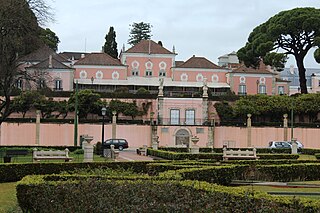
The Belém Palace, formally the National Palace of Belém,, is the current official residence of the President of the Portuguese Republic, the head of state of Portugal. Located in the Belém District of Lisbon, the palace's main façade fronts the Praça Afonso de Albuquerque, facing the Tagus River. A former residence of the Portuguese Royal Family, the Belém Palace complex is made up of various buildings, wings, courtyards, and gardens, built variously from the 18th to 21st centuries.

The Buen Retiro Park, Retiro Park or simply El Retiro is one of the largest parks of the city of Madrid, Spain. The park belonged to the Spanish Monarchy until the late 19th century, when it became a public park.

The Royal Palace of Madrid is the official residence of the Spanish royal family at the city of Madrid, although now used only for state ceremonies. The palace has 135,000 m2 (1,450,000 sq ft) of floor space and contains 3,418 rooms. It is the largest functioning royal palace and the largest by floor area in Europe.

The Royal Palace of Aranjuez is a former Spanish royal residence. It is located 50 km south of Madrid in the town of Aranjuez, Spain.

The Government Palace, also known as the House of Pizarro, is the seat of the executive branch of the Peruvian Government, and the official residence of the President of Peru. The palace is a stately government building, occupying the northern side of the Plaza Mayor in Peru's capital city, Lima. Set on the Rímac River, the palace occupies the site of a very large huaca that incorporated a shrine to Taulichusco, the last kuraka of Lima.

The Palacio de Miraflores is the official residence of the President of Venezuela. It is located on Urdaneta Avenue, Libertador Bolivarian Municipality in Caracas.
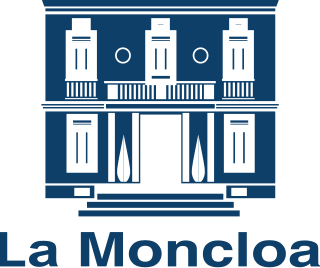
The Palace of Moncloa or Moncloa Palace is the official residence and workplace of the Prime Minister of Spain. It is located in Puerta de Hierro Avenue, in the Moncloa-Aravaca district in Madrid. It has been the official residence of the Prime Minister of Spain since 1977, when Adolfo Suárez moved the residence from the Palace of Villamejor.

The Royal Alcázars of Seville, historically known as al-Qasr al-Muriq and commonly known as the Alcázar of Seville, is a royal palace in Seville, Spain, built for the Christian king Peter of Castile. It was built by Castilian Christians on the site of an Abbadid Muslim alcazar, or residential fortress. The fortress was destroyed after the Christian conquest of Seville in 1248.

The National Palace is the seat of the federal executive in Mexico. Since 2018 it has also served as the official residence for the President of Mexico. It is located on Mexico City's main square, the Plaza de la Constitución. This site has been a palace for the ruling class of Mexico since the Aztec Empire, and much of the current palace's building materials are from the original one that belonged to the 16th-century leader Moctezuma II.
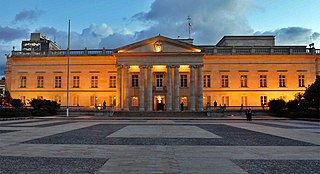
The Palacio de Nariño or Casa de Nariño is the official home and principal workplace of the President of Colombia. It houses the main office of the executive branch and is located in the capital city of Bogotá, Colombia. It was dedicated in 1908 after being constructed on the site of the house where Antonio Nariño was born. The design was made by architects Gaston Lelarge, a French-born former pupil of Charles Garnier, and Julián Lombana.
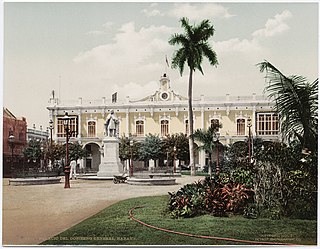
The Palacio de los Capitanes Generales is the former official residence of the governors of Havana, Cuba. Located on the eastern side of the Plaza de Armas in Old Havana it is home to the Museum of the City of Havana. It houses exhibitions of art and historical artefacts and many of the rooms are preserved with their original Colonial decoration.

Casco Viejo, also known as Casco Antiguo or San Felipe, is the historic district of Panama City. Completed and settled in 1673, it was built following the near-total destruction of the original Panamá city, Panamá Viejo in 1671, when the latter was attacked by pirates. It was designated a World Heritage Site in 1997.

Palacio de las Dueñas is a palace in Seville, Spain, currently belonging to the House of Alba. It was built in the late 15th century in the Renaissance style with Gothic and Moorish influences. The palace is one of the major historic homes in the city of great architectural and artistic heritage. The poet Antonio Machado was born here, as were Carlos Falcó, Marqués de Griñón and Marqués de Castelmoncayo. On October 5, 2011 Cayetana Fitz-James Stuart, 18th Duchess of Alba married here. It became a national monument, now a "Bien de Interés Cultural", on June 3, 1931.

The Palacio Liévano or Lievano Palace Is a building located on the west side of the Plaza de Bolivar in Bogotá, Colombia in the cultural and historical hub of the city. The palace is located in La Candelaria district. Along the cobblestone streets of La Candelaria are other formal buildings such as the Plaza de Bolivar, the Palacio de Justicia, and the Casa de Nariño, as well as a library and museums.

The Palacio de la Ribera was the summer residence of Philip III in Valladolid. It was built in the 17th century (1602-1605) as part of a process of urban transformation upon the establishment of the Spanish Court in Valladolid between 1601 and 1606. The palace was situated at the Huerta del Rey neighborhood, located across the Parque de las Moreras on the right bank of the Pisuerga river. The palace grounds extended from the Puente Mayor to Ribera de Don Periáñez del Corral and delimited at both sides by the Pisuerga river and the Camino del Monasterio del Prado. The palace was gradually abandoned until it became part of the destroyed cultural heritage of Valladolid in 1761. Some ruins of the building are still preserved.





















